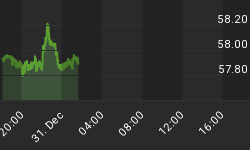Below is an excerpt from a commentary originally posted at www.speculative-investor.com on 7th August 2011.
If you look at a multi-decade chart comparing the yield on a 3-month Treasury Bill with either the Fed Funds Rate (FFR) or the Discount Rate, you will see that the short-term interest rate set by the Fed almost always follows the short-term "risk free" interest rate set by the market. Therefore, if this chart is all you have to go on you will probably conclude that the market sets interest rates and the Fed does little more than tag along behind the market, which is exactly the conclusion reached by the author of the article posted HERE. However, when assessing the Fed's role we have a lot more to go on than a simplistic chart comparison of the T-Bill yield and the Discount Rate.
In the 98 years since the birth of the Fed, the US$ has lost at least 97% of its purchasing power. In the 98 years prior to the birth of the Fed, the US$ lost approximately none of its purchasing power. Unless you are going to argue that the Fed had nothing to do with the dollar's loss of purchasing power or that currency depreciation doesn't affect interest rates, this, alone, tells you that the Fed has a big effect on interest rates.
The dollar's substantial loss of purchasing power is a consequence of substantial growth in the US money supply, which the Fed has played a big part in. To be more accurate, the Fed has played two parts. First, it created a lot of new money via its "Quantitative Easing" (QE) programs over the past few years. Second, although most new money was created (loaned into existence) by the commercial banking sector prior to 2008, the Fed's 'backstopping' of the commercial banking sector was critical. The Fed always stands ready, willing and able to provide whatever reserves the banking system needs, which ensures that the private banks never run short of reserves regardless of how much new deposit money they create.
Importantly, the growth in the money supply that the Fed brings about directly (via QE) or indirectly (by 'backstopping' the private banks) doesn't only lead to a fall in the purchasing power of the currency (a rise in the so-called "general price level"). As per the work of Mises, Rothbard et al, it also leads to changes in relative prices, which result in the widespread mal-investment that forms the basis of the debilitating boom/bust cycle.
Getting back to the lead-lag relationship between the T-Bill yield and the interest rate set by the Fed, it's important to understand that the markets are constantly trying to anticipate the Fed. In this regard, the Fed is helpful. First, the Fed generally goes out of its way not to surprise the markets, which means that it hints at policy changes well before these changes are implemented. QE2 is a classic example, with Bernanke dropping clear hints to the markets in August of 2010 that another round of QE would get underway a few months later. Second, while it is difficult to predict what the markets are going to do, by analysing how the Fed has reacted in the past it is relatively easy to predict how it will react to future changes in the financial markets and/or the economic data. So, if a credit-market speculator foresees a set of conditions that typically provokes a cut in the Fed Funds rate, the speculator will probably get positioned for lower short-term interest rates even if he believes that higher short-term interest rates are appropriate. In other words, market interest rates are strongly influenced by what market participants expect the Fed to do. Take the Fed out of the equation and market interest rates would likely be very different.
Unfortunately, the Fed's effect on interest rates is so pervasive that it isn't possible to determine where interest rates would be in the absence of the Fed. The Fed is constantly trying not to surprise the markets and the markets are constantly trying to anticipate the Fed. What we end up with are interest rates that usually do not signal what they are supposed to signal -- interest rates that bear no resemblance to the economy-wide balance between saving and consuming. No wonder the economy is in a downward spiral.
The bottom line is that the Fed doesn't control the markets, but it has a lot of control over the "risk free" short-term interest rate. Furthermore, its actions distort the prices of everything, not just the price of short-term credit. These price distortions are often unintended, such as when the attempts to prop-up the bad investments of one bubble cause a bubble to form somewhere else.
We aren't offering a free trial subscription at this time, but free samples of our work (excerpts from our regular commentaries) can be viewed at: http://www.speculative-investor.com/new/freesamples.html
















